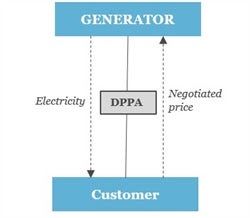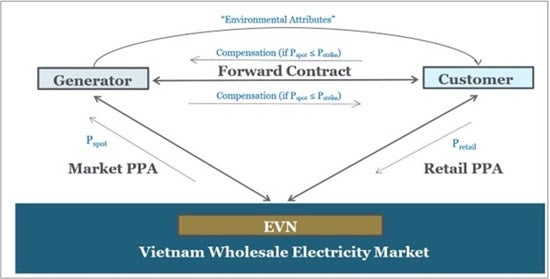On July 3, 2024, the Vietnamese government issued Decree No. 80/2024/ND-CP (Decree 80), moving forward with its long-awaited mechanism for direct power purchase agreements (DPPAs) after months of circulated proposals and drafts. Taking effect upon release, Decree 80 brings substantial changes to the Vietnamese energy market for both consumers and producers. This GT Alert outlines the two DPPA mechanisms introduced by Decree 80, the applicable pricing guidelines, and the next steps for DPPAs in Vietnam.
What’s New
- Decree 80 establishes two DPPA models: the Private Line Model (PLM) and the Grid-Connected Model (GCM).
- It focuses on large energy consumers and allows generators to bypass the Vietnam Wholesale Electricity Market (VWEM) through the PLM.
Private Line Model (PLM) / Physical PPA
The Private Line Model involves the direct transfer of electricity through a private connection line from a power generator using renewable energy sources (i.e., solar, wind, small hydro, biomass, geothermal, ocean wave, tidal, and marine current) (Generator) to a large electricity customer (Customer) through the following process:
- Generator and Customer agree on the terms of the power purchase agreement, including price. There is no template for the power purchase agreement to be entered into under the PLM.
- Electricity is directly transferred from the Generator to the Customer.
- Within 10 days of signing the agreement, the Customer reports the transaction to the local Peoples’ Committee, copying Vietnam Electricity Group (EVN) and the National Load Dispatch Centre (NLDC).

In order to participate in the PLM, Customers must:
- consume at least 200,000 kWh of electricity per month, as demonstrated by the previous 12 months of consumption;
- not resell any power purchased through the PLM DPPA;
- send annual reports of DPPA transactions to the Ministry of Industry and Trade (MOIT).
With respect to Generators, while there is no minimum generating capacity threshold that is imposed, where the capacity of the Generator exceeds 1 MW, the Generator must obtain an Electricity Operating License from EVN. Generators should note that the construction of the private electricity line to the Customer will require a license from EVN, although the details of these licensing requirements are still to be clarified. In addition to the physical PPA that will be entered into with the Customer, the Generator may also enter into power sale arrangements with EVN to sell any excess power.
In terms of pricing, as a general rule, the Generator and Customer are free to negotiate the sale price. The only restriction occurs in circumstances where the Generator is a Zone Electricity Retailer operating in industrial/hi-tech zones that purchase power from the national grid. Where this occurs, the pricing is determined by EVN.
Grid-Connected Model (GCM) / Synthetic PPA
The GCM involves the sale and purchase of electricity under a forward contract between the Generator and the Customer. Participation in the GCM is more restricted and occurs through VWEM, with EVN acting as an intermediary between the Generator and the Customer. The GCM is summarized as follows:
| 1. | Forward Contract: Generator and Customer enter into a forward contract in which the parties agree the power purchase price (Pstrike), with the applicable party compensated for any difference between the negotiated price and the market / spot price. If Pstrike < Pspot, the Generator pays the difference to the Customer, and vice versa if Pstrike > Pspot. |
|
| 2. | Market PPA: Generator and EVN enter into a power purchase agreement (PPA) to sell power to VWEM at the market / spot price, calculated after each 30-minute transaction cycle (Pspot) and including operation costs. |
|
| 3. | Retail PPA: Customer enters a retail PPA with EVN (or its subsidiary) to buy the equivalent amount of electricity for a negotiated price (Pretail). |
|
| 4. | Renewable Energy Certificates (RECs): The Generator transfers “environmental attributes” to the Customer. Note that there is some uncertainty regarding the scope of this as explained below. |

In order to participate in the GCM, the Customer is required to satisfy the same minimum consumption requirements as per the PLM. In addition, the Customer must have a connection voltage of 22 kV or higher. Customers are required to register with the NLDC.
For Generators, participation in the GCM is limited to Generators with wind and / or solar projects and a capacity output of at least 10MW. Generators are required to register with the NLDC and the VWEM.
Pricing in GCM Transactions
As referred to above, there are three relevant prices for the GCM:
(1) Pstrike: Negotiated price between the Generator and the Customer.
(2) Pspot: The market / spot price that is payable by EVN under the PPA is determined using the formulae set out in Decree 80:
Pspot = ∑Ii = 1QKHhe(i) × CFMP(i) × KPP
Where:
- i = the transaction cycle during which the DPPA takes place;
- QKHhe(i) = the adjusted energy consumption volume;
- CFMP(i) = the VWEM clearing price; and
- KPP = the coefficient factor determined by MOIT.
(3) Pretail: The negotiated price between the Customer and EVN (or its subsidiary) is also determined using the formulae set out in Decree 80:
Pretail = ∑Ii = 1(QKH(i) – QKHlu(i)) × PBL(i)
Where:
- i = the transaction cycle during which the DPPA takes place;
- QKH(i) = the actual energy consumption volume;
- QKHlu(i) = the energy consumption volume, adjusted to reflect renewable energy consumption; and
- PBL(i) = the retail price set by MOIT to cover transmission costs.
Other Takeaways
As with all energy transactions within its jurisdiction, EVN appears intent on maintaining its suspension and termination rights over Generator and Customer participation in the DPPA programs. According to Decree 80, EVN’s right to exercise such suspension or termination right applies where the relevant participant has misused the DPPA program for “personal gain” with “irreversible consequences,” neither term being defined in Decree 80, nor does the decree establish whether EVN is the relevant authority for evaluating such claim against a market participant. Participation in the DPPA program may also be suspended if a Customer’s monthly average energy consumption no longer meets the minimum threshold of 200,000 kWh.
Renewable Energy Certificates (RECs) are explicitly mentioned in Decree 80 (unlike prior drafts) as belonging to Generators to be bundled with electricity and transferred to Customers. However, whether this is the same as the “environmental attributes” transferred to Customers in GCM transactions is unclear.
In the case of rooftop solar, it is unclear whether participation in physical PPAs will be subject to total capacity limitations proposed under Power Development Plan VIII (PDP8), which proposed an increase in self-produced and self-consumed rooftop solar generation of 2,600 MW.
Regulatory uncertainty and operational vulnerability create risks for Generators and Customers engaging in DPPA transactions. Required reporting to various government bodies may raise costs, as may the negotiation of forward contracts in GCM transactions. Given lack of clarity in sections of Decree 80, projects may face compliance challenges with the ongoing underlying risk of suspension or termination of DPPAs by EVN.
Next Steps
The MOIT is expected to release a specific formula for calculating market / spot prices for each 30-minute transactions cycle and clarifying the meaning of “environmental attributes.” There is also an upcoming circular update, Circular 45/2018/TT-BCT, on VWEM operational rules to reflect changes made by Decree 80. It may propose revisions to PDP8 based on the outcomes of the DPPA mechanism, and Decree 80 may be amended to comply with the Electricity Law.
EVN is updating its internal regulations to fully comply with Decree 80 by the end of July, as well as performing internal training for its subsidiary power-generating companies. Each year, EVN subsidiaries are responsible for calculating the power distribution loss coefficient in a transaction cycle, to be published by EVN before 30 November. It will also calculate DPPA charges for each power unit, to be approved and published by the MOIT before 15 December. Finally, the cost of clearing differences per unit of power will be calculated and published by EVN before the thirtieth day of each month.
The National Assembly of Vietnam is preparing to pass an amended Electricity Law, of which three drafts have already been circulated. This will happen either in the upcoming October session or in May 2025. The law will provide further guidance on the DPPA mechanism and clarify uncertainties in Decree 80.




 />i
/>i

